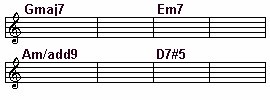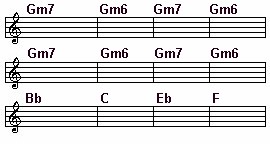
ROCK
LEGENDS III - JEFF BECK
Jeff Beck Lesson Sample
Lyle:
Although he hasn't had the huge hit songs or notoriety like his contemporaries
have had, Grammy Award winning guitarist Jeff Beck is one of the best rock
guitarists of all time. Instead of recording songs aimed for commercial success
with a vocalist, he chooses to do what he wants to do, mostly work at his
obsession of rebuilding hot-rod cars. But every now and then he releases a new
instrumental album that displays his incredible
talent.
Lyle: When
Eric Clapton left the Yardbirds, Jeff Beck took his place as the group's lead
guitarist. Two years later Jeff left the group to form his own band, The Jeff
Beck Group featuring Rod Stewart on vocals. A few years later Jeff began
recording many of his solo instrumental albums, which feature some of the
world's most incredible guitar riffs. Jeff is known as the first rock
guitarist to use distortion as well as the first to popularize the talk box,
years before Peter Frampton used it on "Do You Feel Like I
Do?" Beck has always embraced modern
technology in music creation and many of his latest albums are great examples of
this, utilizing samplers, sequencers, and other digital recording
tools.
Lyle: Many
guitarists have sat with their mouths hanging wide open as they watched and listened to
Beck pulling sounds and notes from just his guitar, a Fender Strat and Marshall
amp. He generally plays without a pick, using his thumb and fingers
instead.
Suggested listening: Truth, Blow By Blow and Wired -- still among the best
selling guitar albums of all time.

Lyle: In this lesson I suggest you learn how
to play these riffs without using a
pick. JB mostly used his
fingers. If you have a guitar with a whammy bar,
get it ready! Also, try setting your tone to the cleanest sound you can get,
maybe add a little reverb too for this intro
section.
Lyle: For
the intro riffs, the background chord progression, in the key of G
major, is like this:
chord chart - intro

Lyle:
Here's a jam track of these chords:
Looping Sound Clip 1
Lyle: The solo riffs have many "pre-bends"
using a whammy bar. Look and listen to this next
tab:
pre-bend example
Lyle: In the following tab examples, the "V"
means bend the bar down, pick the note, and release the
bar. Here's
the first riff of the intro solo:
solo
1 - riff 1
Stratman: Is the vibrato
achieved with the finger or the bar?
Lyle: The whammy bar is used for the
vibrato.
Here's riff 2:
solo 1 - riff
2
Lyle: This is a pre-bend up with your finger,
but the volume of the guitar is off. After you pick the note, turn on the volume
of you guitar as you slowly release the
bend. Watch the video clip for a closer look
at this.
Lyle: The next riff is not too
hard:
solo 1 - riff 3
Lyle: This next riff is my favorite
riff of the whole solo, very bluesy:
solo 1 - riff
4
Lyle: All 4 of those riffs put together is
half way through the intro solo.
Lyle: Here's the second half of the intro
solo:
solo 1 - riff 5
Lyle: How I came up with these riffs
was I played against the chords, using arpeggios like in riff 5 and in riff
6:
solo 1 - riff 6
Lyle: Riff 5 is a Gmaj7 arpeggio, riff 6 is an
Em7 arpeggio, just following the chords in the chord
progression.
solo 1 - riff
7
Lyle: This next tab is all the riffs put
together. Be sure to listen to the embedded audio
of the tab file:

Lyle: Let's shift gears to the rest of the
lesson sample, where the band comes in. It's a jam based off two chords in
G:
chord chart -
rhythm riff 1

Lyle:
Here's the new jam track:
Looping Sound Clip 2
Lyle: The first riff sounds like the old Moog
synths if played fast. For a tone setting for this sound, try using a high
gain distortion, neck pickup.
solo 2 - riff
1
Lyle: The video clip will help you see and
hear it played fast.
Lyle: For this next riff, use the same high
gain distortion sound, but select a single coil pickup on your guitar if you
have one.
solo 2 - riff
2
Lyle: Notice you're snapping the string with
your finger to produce the sharp attack. The next riff goes back to the clean
sound. You'll pre-bend up a half step, then
pick the two notes and release the bend:
solo 2 - riff
3
Lyle: Beck changes around his volume, tone and
pick-up switch all the time to create the seemingly endless tones from his
Strat.
Lyle: I learned a riff like this next one from
a Jeff Beck song long ago, I don't even remember which one now. It goes like
this:
solo 2 - riff 4

Lyle: The next riff is from the
"chorus" section of the lesson sample. The chord
progression for this part is simply this:
chord chart - rhythm riff 2

Lyle: Here I want to show you how JB
might use the whammy bar make chords sound like they're being played with a
slide:
chorus riff
Lyle: Try it with this jam
track:
Looping
Sound Clip 3

Lyle: Now if you feel like jamming to both
rhythm riffs, here's how they go
together:
chord
chart - both rhythm riffs

jam track - both rhythm riffs
Lyle: You can use the riffs you learned for
both parts as well as any you come up with using any G minor pentatonic scale, G
minor blues, even the G Dorian minor scale.
Lyle: If you don't have any Jeff Beck
albums/CDs, do yourself a favor and pick up a couple, he'll amaze you. You'll
have to listen carefully, he throws in lots of riffs all over the place,
sometimes it doesn't sound like a guitar but it is! He doesn't use effects, just
his guitar and amp.
Lyle: If you want to explore more of this
style, you can with private customized lessons with me using this same Riff
Interactive technology you're using here. Email me at Lyle@theguitar.net for
more info, I'll be more than happy to help you. Thanks,
Lyle
